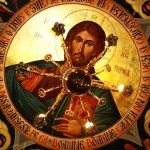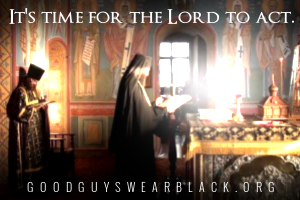by Fr. Patrick Henry Reardon
 A progressive scheme of images is developed through the first three psalms: First,
A progressive scheme of images is developed through the first three psalms: First,
the Man (Psalm 1), then
the Messiah (Psalm 2), and finally
the Suffering Servant (Psalm 3).
Since this triadic pattern of reference runs throughout the Psalter, one may regard these three psalms as the book’s proper “introduction.” They form the tripod on which the Psalter stands.
First, the Man: Psalm 1 is not a prayer in the usual sense, inasmuch as there is no direct address to God. It is, rather, a meditation on a Wisdom theme: How the righteous man lives and what he hopes for. The affirmations in this psalm are made in the calm, apodictic style of Proverbs and the Bible’s older Wisdom tradition.
If the form of the psalm is given by the Wisdom literature, its matter is from the Torah. Who, after all, is this Man of Psalm 1? Well, to begin with, he is the first Man in the Torah—righteous Adam—Man before the Fall, when he was still God’s friend. As Adam tilled the Garden irrigated by four rivers (Genesis 2:8-15), the Man in Psalm 1 is likened to
“a tree / planted by the rivers of water, / that brings forth its fruit in its season, / whose leaf also shall not wither, / and whatever he does shall prosper.”
Of the Man described in this psalm, we are told that his “delight is in the Lord’s Torah, / and on His Torah he meditates day and night.” The “day and night” of this psalm were also introduced, we recall, at the beginning of the Torah.
In contrast to the stability of this godly Man, Psalm 1 speaks of the “wicked”—the rasha’im, who are likened to
“the chaff which the wind drives away.”
” Just as the former does not stand in the path of sinners nor sit in the seat of pestilence, so “the rasha’im shall not stand in the judgment, / nor sinners in the congregation of the righteous.”
Second, the Messiah: In Psalm 2, Adam becomes David. The Man is transformed into the King, God’s Anointed One. At this point the pace of the Psalter dramatically quickens, as it moves from calm meditation to robust narrative. The Torah and the Wisdom Literature are replaced by the Former Prophets, particularly the Samuel/Kings saga.
The contrast in Psalm 1 grows into the conspiracy of Psalm 2. Indeed, open rebellion is afoot, as the
“kings of the earth set themselves, and the rulers take counsel together, against the Lord, and against His Messiah.”
For this reason, the style of the Psalter moves from apodictic declaration to energetic inquiry:
“Why did the nations rage, and the people conspire at something futile?”
As the ungodly in Psalm 1 were as “chaff which the wind drives away,” so here,
“You shall break them with a rod of iron; / You shall dash them to pieces like a potter’s vessel.”
Third, the Suffering Servant: The trouble is serious and personal in Psalm 3. The Second Adam and the New David become the persecuted righteous man, so memorably portrayed in the second part of Isaiah. Psalm 3 speaks, for the first time, of “salvation”—Yeshu’ah.
In the first two psalms, God was never directly addressed—“You.” This changes completely in Psalm 3:
“Lord, how increased they are who afflict me! / Many they are who rise up against me. Many, as well, are those who say of me, / ‘There is no help for him in God.'”
The vile activity of the rasha’im in Psalm 1 and of the raging nations in Psalm 2 is now experienced first-hand in the persecution of the Suffering Servant, who
“will not be afraid of ten thousands of people that besieged me all around.”
As for the rasha’im—those “ungodly” introduced in Psalm 1—Psalm 3 declares,
“You have broken the teeth of the rasha’im.”
In these opening psalms, then, three major Christological themes are set forth to establish the patterns of meditation, narrative, and prayer found throughout the Psalter. Likewise, among these three psalms, other parts of Sacred Writ are introduced: Torah, Prophecy, and Wisdom.
These three psalms also exemplify various “voices” in the Psalter. First, we attend to the meditating wise man, next the raging nations, then the Messiah (“The Lord said to Me”), next the Father, who addresses both us (“I have set My King on My holy hill of Zion”) and the Messiah (“You are My Son”). Finally, the Suffering Servant declares:
“Yeshu’ah is of the Lord. / Your blessing be upon Your people.”
